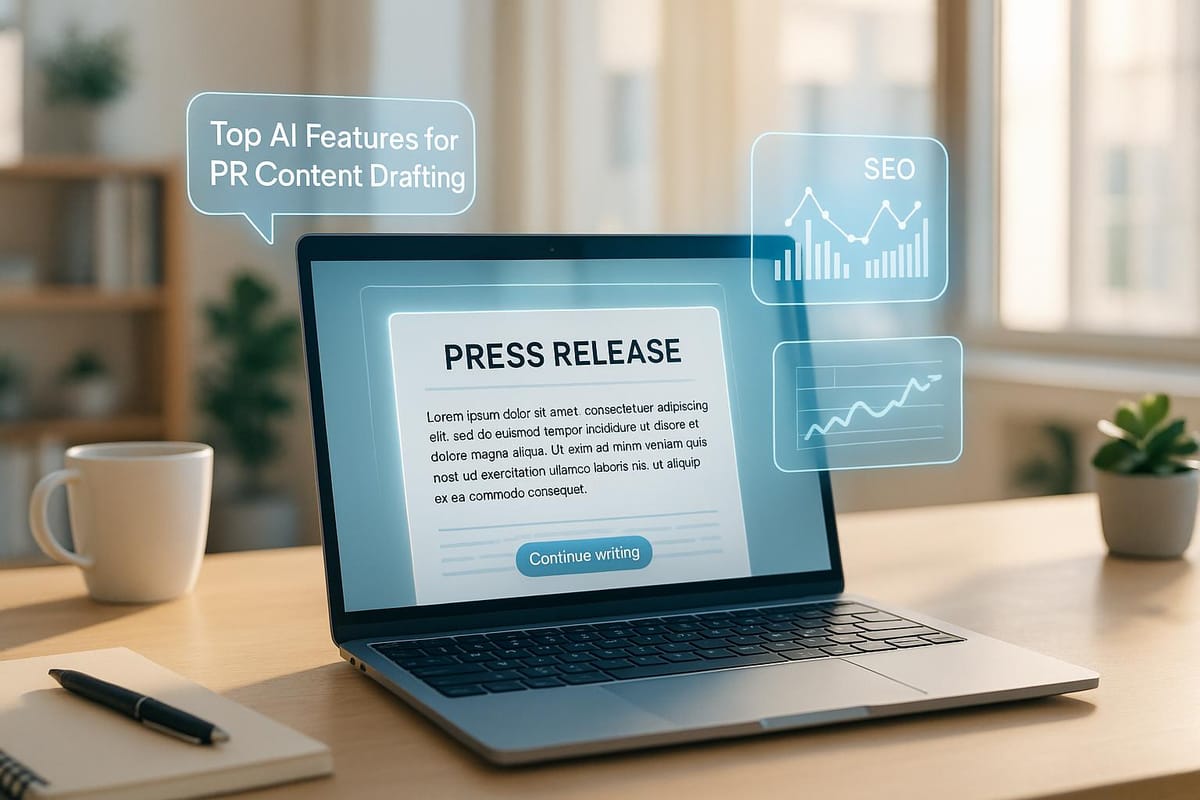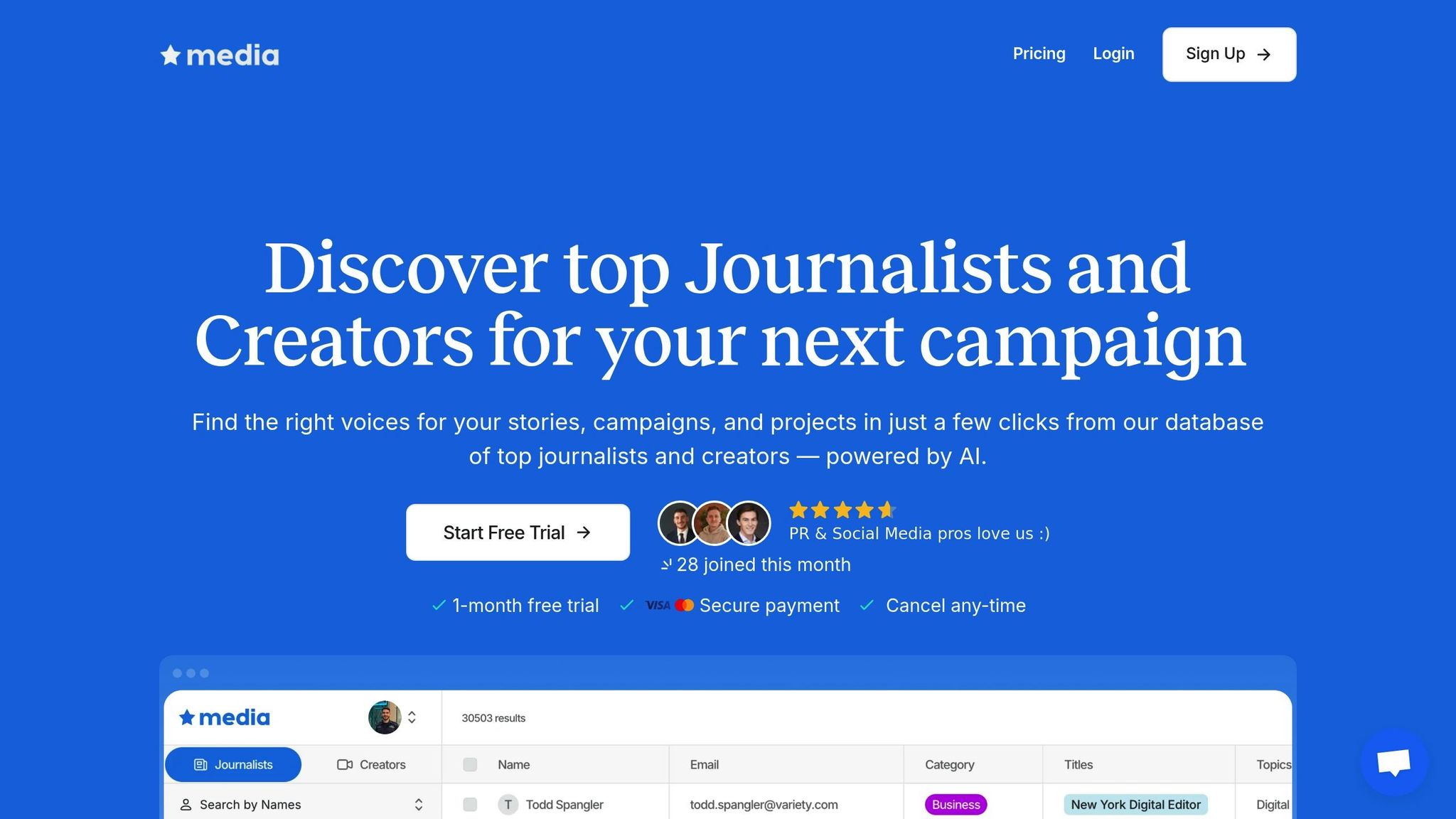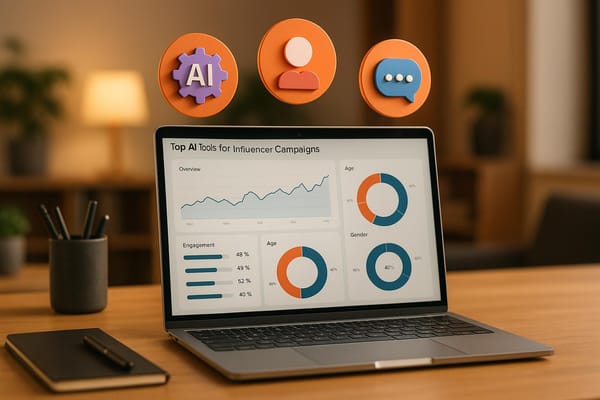Top AI Features for PR Content Drafting
Explore how AI is revolutionizing PR content creation, from drafting press releases to optimizing SEO and streamlining media outreach.

AI is transforming PR content creation by automating repetitive tasks, speeding up workflows, and improving content precision. Here's how:
- Faster Press Releases: AI tools like Notified's Personalized Pitch turn basic inputs into polished drafts, saving time and effort.
- Headline & Story Ideas: AI analyzes trends to suggest attention-grabbing headlines and fresh angles tailored to target audiences.
- Tone Consistency: Tools like Jasper AI provide sentiment analysis and ensure content aligns with brand voice and campaign goals.
- SEO Optimization: AI platforms suggest keywords and improve content visibility by analyzing search trends and user intent.
- Efficient Editing: AI-powered grammar and readability checks reduce revision cycles and streamline approvals.
- Media Outreach: Platforms like Media AI simplify journalist discovery with a database of 30,000+ contacts, advanced filtering, and easy integration.
These features allow PR professionals to focus on strategy and storytelling while AI handles routine tasks, ensuring campaigns are precise, timely, and effective.
3 Best AI Tools to Get Featured in the Media
Automated Content Creation and Idea Generation
AI is transforming the way PR professionals approach content creation and brainstorming. By turning basic inputs into polished drafts in just minutes, these tools are reshaping the industry. They rely on analyzing massive datasets and using generative AI to craft tailored content based on user-provided details - like news specifics, industry focus, and target audience. The quality of the output often depends on the data source, with specialized tools outperforming consumer-grade options.
According to a 2024 Muck Rack survey, PR professionals are leveraging AI in various ways: 58% use it for research, 54% for pitching, 26% for press release drafting, nearly half for headline development, and 41% for writing body copy. Let’s take a closer look at how AI is reshaping key PR tasks, from press release creation to headline ideation.
AI Press Release Creation
AI has made drafting press releases faster and more efficient. By inputting essential details - like the announcement, target audience, background information, and tone - teams can generate complete drafts that follow standard press release formats. This allows PR professionals to spend less time on initial drafts and more time refining the final message.
For example, Notified introduced a feature in June 2025 called Personalized Pitch, showcasing the potential of AI-powered tools. Users provide details such as the topic, value proposition, key points, and quotes, and the tool generates three tailored drafts based on journalist preferences and profile data. Users then select their preferred draft and make adjustments to fit their needs.
PR teams can take these AI-generated drafts and fine-tune them to align with their brand voice and guidelines. This blend of AI efficiency and human creativity ensures that the content remains unique and impactful.
"By combining AI-powered personalized pitching with our human-verified journalist database, we're amplifying the human perspective to foster more meaningful media engagement while providing an all-in-one solution for modern communications teams. AI-powered pitching will allow PR professionals to spend time researching, and building context and connections, to further personalize journalist outreach." - Erik Carlson, Chief Operating Officer at Notified
The secret to getting the best results lies in crafting specific and detailed prompts. Vague instructions lead to generic content, while clear, precise briefs produce drafts that require minimal editing.
Headline and Story Angle Ideas
AI isn't just useful for structured tasks - it also shines in creative brainstorming. It can generate multiple headline options and uncover fresh story angles that might not immediately come to mind. By analyzing trending topics and predicting audience reactions, AI tools suggest newsworthy approaches tailored to different media outlets. They create concise, attention-grabbing headlines and offer variations to suit various audience segments.
These tools also help PR teams refine their messaging by identifying emotional triggers and crafting detailed audience profiles. By analyzing engagement patterns and preferences, AI enables teams to customize their messaging for different groups, ensuring a more targeted and effective approach.
Companies like Frantz Marketing Solutions have already embraced these advancements. Susan Frantz, the company’s CEO, highlighted the benefits:
"The team at Frantz Marketing Solutions has proactively embraced Notified's cutting-edge AI technology, which positions us at the forefront of the public relations industry. By adopting AI early, we're not only streamlining our operations, but also connecting with our media clientele more effectively. This advanced approach optimizes our ability to secure media pickups, ensuring that our clients' messages resonate more deeply with their target audiences." - Susan Frantz, Chief Executive Officer and Founder of Frantz Marketing Solutions
The real power of AI in PR comes from combining its analytical and generative capabilities with human expertise. While AI handles data analysis and initial drafts, PR professionals focus on storytelling, building relationships, and crafting strategies that resonate on a deeper level. Together, they create a more efficient and impactful workflow.
Tone and Brand Voice Control
After generating content with AI, fine-tuning the tone is essential to ensure your messaging stays consistent with your brand’s identity. Getting the tone right isn’t just a nice-to-have; it’s a cornerstone of PR success. Many of today’s AI tools are equipped with advanced features that analyze the emotional undertone of your content, helping you adjust the style to match your brand guidelines. For US audiences, clarity and culturally relevant communication are especially important. Let’s dive into how AI uses sentiment analysis to refine tone.
Modern AI leverages natural language processing to evaluate emotional cues, word choices, and sentence structures, ensuring your content aligns with your campaign goals. These tools assess whether your tone feels positive, neutral, or negative and suggest changes to better support your objectives. This capability is particularly valuable for PR teams juggling multiple brands or campaigns, where maintaining consistent messaging across different formats can be a real challenge.
Sentiment and Tone Analysis
AI-powered sentiment analysis goes far beyond simple grammar checks. These tools evaluate the emotional impact of your PR content and recommend tweaks to ensure your message lands as intended. For campaigns targeting US audiences, this might involve using American spelling, familiar expressions, and references that resonate culturally.
Some tools, like Buffer's AI Assistant and Narrato AI Content Genie, provide real-time feedback on tone. Users can specify the tone they’re aiming for - whether it’s professional, conversational, friendly, or urgent - and receive instant suggestions tailored to the US market.
Other platforms, such as Jasper AI and Writesonic, take it a step further with detailed sentiment analysis reports. These reports help PR professionals understand how different audience segments might perceive their messaging. By catching subtle shifts in tone, these tools ensure your communications reinforce, rather than detract from, your campaign goals.
Brand Voice Setup
Refining tone is just the beginning. AI can also help you establish and maintain a consistent brand voice. This goes beyond simply choosing a tone from a dropdown menu. The most effective AI platforms allow you to upload brand guidelines or sample content, enabling the tool to learn and replicate your company’s unique voice. For instance, Jasper AI excels at this by letting users integrate detailed style guides and existing materials, helping the AI adapt quickly to your specific needs.
Setting up your brand voice typically involves defining its key attributes. Are you aiming to sound authoritative or approachable? Formal or casual? Cutting-edge or more traditional? Many tools even let you specify preferred vocabulary, highlighting words that align with your brand while avoiding those that don’t.
For PR agencies handling multiple clients, this functionality is a game-changer. Instead of reworking content manually for each brand, teams can switch between voice profiles and generate on-brand drafts in seconds. This not only streamlines the editing process but also ensures the content stays aligned with evolving brand standards and campaign goals.
Keyword Optimization and SEO for PR
Keyword optimization takes AI-assisted content drafting to the next level, ensuring your PR messages are not just engaging but also easy to find. With AI tools, you can dive into search engine data to uncover competitive keywords and gain personalized insights. These tools focus on conversational queries and contextual relevance, making them especially effective for connecting with US audiences. This approach creates a strong foundation for PR campaigns designed to perform and deliver results.
The numbers back this up. 71.5% of respondents report using AI tools for search, with 14% using them daily. However, 79.8% still rely on Bing and Google for general searches. To succeed, your PR content must cater to both traditional search engines and modern AI-driven algorithms.
"Unlike the basic keyword matching of traditional search engines, AI algorithms prioritize conversational queries (how people naturally communicate) and contextual relevance (understanding the intent and relationships between words) to offer results that better align with user intent." - Adam Christensen, Chief Marketing Officer, Notified
Real-Time SEO Tips
AI tools give PR professionals a huge advantage by offering instant feedback and real-time trend data. These platforms use Natural Language Processing (NLP) to analyze both structured elements like headlines and metadata, as well as unstructured content such as paragraphs and multimedia. This means they can suggest specific keywords to increase visibility and relevance.
For instance, instead of using generic terms like "new product", opt for more precise phrases like "sustainable tech innovation." This aligns your content with how AI interprets user queries. AI tools also help you stay ahead of the curve by tracking how competitors are being discussed and identifying emerging topics early.
When writing for US audiences, structure your content for both clarity and AI readability. For example, instead of saying, "Our product launches in December", reframe it as, "When is the product launching? It's set for December 15." This mirrors how people naturally phrase their searches.
"Press releases can no longer just tell - they need to answer. PR teams must anticipate the questions people will ask about announcements and build those Q&As directly into the release - such as cost, availability and key features of products or services." - Notified
By using these insights, PR teams can fine-tune their strategies to ensure their campaigns resonate with their target audience.
Performance Data for Targeted Campaigns
AI-powered SEO tools go beyond traditional options, offering deeper insights and additional features. They help PR teams identify which keywords drive meaningful engagement and media coverage - not just high search volumes. This type of performance data is especially valuable when targeting specific US regions or audience segments.
To make the most of these tools, combine AI recommendations with clear campaign goals. Focus on keywords that align with your audience’s buyer journey. Using a mix of general AI tools (like ChatGPT or Google Gemini) and specialized keyword research platforms ensures you get a well-rounded view of keyword performance. While general tools are great for content creation, specialized platforms provide essential metrics like search volume, keyword difficulty, and intent analysis.
Keeping your content updated is critical, as user behavior and industry trends evolve quickly. AI tools simplify this by tracking keyword performance in real time and suggesting adjustments as needed. For multimedia, optimize with detailed tags, alt text, and descriptions. Instead of labeling an image "product launch", try something like "CEO John Smith presenting at the EcoTech launch event" to enhance AI readability.
The impact is clear: 80% of businesses recognize the value AI brings. For PR professionals, this means keyword optimization isn’t just about being found - it’s about being found by the right audience at the right time, with content that answers their questions and meets their needs.
Team Editing and Workflow Speed
AI advancements in content creation and editing are reshaping how PR teams collaborate, significantly improving workflow efficiency. With AI-powered tools automating grammar and style checks, teams can shift their focus to more strategic tasks like crafting compelling messages and driving creative direction.
PR agencies have reported launching campaigns up to 30% faster by leveraging AI editing tools that handle tasks like grammar corrections and streamline the approval process. This time-saving advantage is particularly helpful when juggling multiple campaigns or handling last-minute adjustments.
Modern AI tools are far more advanced than simple spell-checkers. They evaluate entire documents for readability, tone consistency, and alignment with brand guidelines. This reduces the need for multiple revision cycles, cutting down the back-and-forth among team members and speeding up content delivery. At the same time, these tools enhance the overall quality of the work in real time.
Grammar and Readability Fixes
AI writing assistants, trained on AP style guidelines, are a game-changer for U.S. PR professionals. They instantly identify grammar mistakes and provide suggestions for rephrasing sentences, ensuring industry standards are met.
With real-time feedback, team members can address issues as they write, avoiding delays caused by waiting for human editors. This not only keeps the creative momentum alive but also lightens the overall editing workload.
For example, a U.S.-based PR firm used Jasper AI to collaboratively draft and refine press releases. By doing so, they reduced their average content turnaround time from three days to just one, all while maintaining AP style compliance and improving message clarity.
AI tools also play a crucial role in maintaining a consistent brand voice across multiple contributors. When trained on specific brand guidelines and prior content, these platforms help enforce uniformity in tone, style, and messaging. This is especially beneficial for larger teams managing diverse projects.
Additionally, AI tools tackle readability challenges by analyzing sentence length, word choice, and paragraph structure. For U.S. audiences, this ensures content flows naturally and aligns with the preferences of American media professionals and consumers. Beyond improving readability, these tools make the entire review process more efficient.
Automated Approvals and Version Control
AI streamlines the approval process by automating workflows. Drafts are routed to stakeholders, reminders are sent, and approvals are logged without the need for manual follow-ups, eliminating common bottlenecks caused by busy executives or clients.
Version control features further enhance collaboration by providing transparency and accountability. Teams can easily track changes, access a history of edits, and revert to earlier versions when necessary. These features are invaluable when multiple contributors are involved or when significant client revisions are required.
Tools like Jasper AI also support real-time collaboration with shared editing, comment threads, and version tracking. Automated reminders help ensure deadlines are met, reducing delays caused by missed communications.
To measure the impact of these tools, PR teams should monitor metrics like content turnaround time, the number of revisions per draft, the duration of approval cycles, error rates in published content, and team satisfaction levels. These benchmarks provide concrete insights into how AI-powered editing tools improve efficiency, quality, and collaboration, enabling faster and more consistent results for competitive campaigns.
Media AI: Changing Journalist and Creator Discovery

AI is revolutionizing how PR professionals find and connect with the right media contacts, and Media AI stands out as a prime example. While AI has been instrumental in transforming content creation and editing workflows, the challenge of identifying the right journalists and creators has persisted. Media AI addresses this by blending AI-powered discovery with a constantly updated database, creating a comprehensive PR solution.
An AI crawler keeps the contact information for top journalists and creators up to date in real time. This means PR professionals can access the latest details without the hassle of manual research, saving time and effort.
Sarah Jones, Marketing Manager at Remote3, shared her experience:
"Media AI made it so easy to find the right collaborators for our campaign. It's a game-changer."
Jackson Nemeth, Business Development at Cibes Lift Group, added:
"I work across several markets in APAC. Media AI helped me find journalists across every one of them."
Extensive Database of Journalists and Creators
Media AI goes beyond real-time discovery by offering a searchable database with over 30,000 U.S.-based journalists and creators. Users can filter results by topic, category, or job title to pinpoint exactly who they need.
Easy Export and Integration
The platform also simplifies integration into existing workflows by enabling contact list exports in formats like Excel and PDF. This flexibility makes it easy for teams to organize, share, and collaborate on media outreach efforts.
How Media AI Stacks Up
Media AI’s competitive pricing and user-friendly features make it a strong alternative to traditional platforms. Here’s a quick comparison:
| Feature | Media AI | Other Platforms |
|---|---|---|
| Database Size | 30,000+ contacts | Varies, often smaller |
| Advanced Filtering | Yes | Limited |
| Export Capabilities | Seamless | Often restricted |
| Pricing (Full Access) | $149/month | $400 to $1,000+/month |
With a monthly subscription of $149 for full access, Media AI is significantly more affordable than other platforms, which often charge $400 to $1,000 per month - or even require long-term contracts costing anywhere from $5,000 to $12,000 annually. Media AI removes these barriers with no long-term commitments and the option to cancel anytime.
For PR teams already leveraging AI tools for content creation, Media AI ensures that their targeted, high-quality content reaches the right contacts, streamlining the entire PR process.
Conclusion: The Future of AI in PR Content Creation
AI tools have become a game-changer for PR teams. According to McKinsey's 2024 survey, 72% of organizations have already adopted AI, and Gartner predicts this number will climb to 80% by 2026. This growing reliance on AI is reshaping how PR professionals approach their work, driving efficiency and innovation.
These tools are doing more than just automating tasks - they’re transforming workflows. AI can draft press releases, fine-tune tone, enhance SEO with real-time keyword suggestions, and streamline editing processes through automated version control. It’s like having an extra set of hands that works faster and smarter.
A staggering 86% of communications professionals see AI as an opportunity, not a threat. One of its biggest strengths lies in rapidly analyzing data to uncover trends, helping teams make sharper, more informed strategic decisions.
For U.S.-based PR teams, platforms like Media AI take things a step further. While AI tools handle content creation, Media AI ensures the message reaches the right audience. With access to a database of over 30,000 journalists, this platform simplifies outreach and enhances the quality of PR campaigns. Combining AI-powered content tools with Media AI creates a seamless workflow that saves time and delivers results.
The future of PR lies in blending AI with human expertise. These tools allow professionals to focus on what they do best - building relationships and crafting strategy. In a fast-paced digital landscape, those who embrace AI will stay ahead of the curve. By integrating AI tools and platforms like Media AI, PR teams can create campaigns that are not only efficient but also impactful and data-driven.
FAQs
How does AI help maintain a consistent tone and brand voice in PR content?
AI plays a key role in maintaining a consistent tone and brand voice in PR content. Using advanced generative models, it aligns with your brand's guidelines to replicate your preferred style, ensuring all communications feel cohesive and on-brand.
Beyond that, AI can fine-tune the tone to match specific emotional nuances, adapting to the context or audience. With real-time analysis, it spots and corrects inconsistencies, helping PR professionals craft messages that connect with their audience while staying true to the brand's identity.
How can AI improve SEO strategies in PR campaigns?
AI is transforming how SEO integrates with PR campaigns by automating critical tasks like keyword research and content optimization. It helps fine-tune content to improve search rankings and aligns messaging with audience search intent. Plus, AI can spot content gaps, guiding PR professionals to create materials that resonate more effectively with their target audience.
By simplifying these processes, AI not only saves time but also increases campaign visibility and drives more traffic. This, in turn, amplifies engagement and delivers stronger results.
How does Media AI simplify finding and connecting with journalists and creators?
Media AI simplifies the task of finding and connecting with journalists and creators through its AI-driven platform. With a database of over 30,000 professionals, it enables PR teams to quickly pinpoint the ideal collaborators for their campaigns and projects.
The platform's advanced filtering tools let users refine their search based on precise criteria, streamlining outreach efforts. By bringing together discovery, filtering, and contact exporting in one place, Media AI not only saves time but also allows PR professionals to concentrate on fostering genuine relationships.





